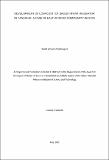Development of low-cost IOT based infant incubator in Tanzania: a case of east African community region
Abstract
Physical adjustment to life outside of the mother's body of a baby might be challenging due to
health issues and other environmental factors. Prematurity is one of the most crucial problems
in Tanzania since it contributes to a greater infant mortality rate. Despite the vital function that
infant incubators play, their operation cost is too expensive for low-income countries to obtain
and it relies only on electricity for their operation. The fundamental goal of this project is to
create an inexpensive, efficient, and dual-powered incubator that saves premature infants' lives.
We developed the system which utilizes ESP32 as the Microcontroller Unit board interfaced
with DHT22, a thermistor for skin temperature computation, MAX30102 to evaluate heart rate
and oxygen saturation in the blood. An oxygen sensor measures the air quality in the chamber,
and a ultraviolet sensor records the light intensity of the phototherapy unit used to treat
jaundice. The computed information is displayed and transferred to a webpage that tracks the
infant's data. When the system detects a critical condition, it sounds an alarm and sends short
messege services to medical personnel via Global System for Mobile Communication. The
system adjusts the environment using a heater, humidifier, and oxygen valve. The final design
was implemented on a Printed Circuit Board and tested after a circuit was designed and
simulated. The sensors were calibrated against standard sensors to receive accurate measured
data, and then transferred via Wi-Fi through the ESP32 to a webpage for remote monitoring
and control. In conclusion, based on the test-performed the developed system can save the lives
of premature babies, is low-cost, and is applicable in areas with limited resources. Furthermore,
we recommend an easy way to assess the functionality of the locally developed systems by the
regulatory institutions involved so as to be implemented successfully.

